 |
|
|
|
|
| |||||
|
|
Optimum ConnectionsNews from Optimum Choices, LLCWelcome to the June 2007 edition of Optimum Connections, the monthly e-newsletter from Russell Louie and Margaret Auld-Louie at Optimum Choices, LLC. This newsletter is sent to the friends and customers of Russell & Margaret as well as people who signed up for a drawing at our booth at a fair or event. If you wish to unsubscribe, see the bottom of this e-mail for instructions. To receive this newsletter in your e-mail, click here. Contents
June Sale
|
|
|
|
|
Single Oils: Lavender, ledum, German chamomile, Roman chamomile |
Blends: Harmony, Valor, Juva Cleanse |
Applications: INHALATION: by diffusing in the air, 15 min every 2 hours, as needed. DIRECT: apply to lungs and throat area 2-4 times daily, as needed. INGESTION: Capsule (00 size), 2 times daily (only to be done by those experienced with essential oils)
You may be wondering why Harmony and Juva Cleanse are useful for symptoms of hay fever. The Harmony oil blend will balances all seven major energy centers of the body thus making sure all the body's systems are energized and working together in harmony. This facilitates a fully functional endocrine (glandular) system which include the adrenals, thyroid and hypothalamus glands that are vital to counteract any histamine reaction. Juva Cleanse will support a stressed liver and enhance the detoxing process as allergens invade the body.
©2005 Essential Science Publishing. Some of the information in this article is from the
Essential Oils Desk Reference, which can be ordered here:
Essential Science Publishing, 1216 South 1580 West, Orem, Utah 84058, (800)
336-6308, www.essentialscience.net.
Click here to order on our Young Living World Essential Oils website. Click on Product Catalog, then pull down the menus Essential Oils/Singles or Blends or call us at (303) 271-1649 or (866) 305-2306 (toll-free).

No, we are not referring to the pet food recall this time (for more information
on the recall, see
www.optimumchoices.com/Pet_Food_Recall.htm). Did you know that
overfeeding your pet can shorten its life and lead to a variety of health
problems? While pictures of fat cats and pudgy pooches posted on the
Internet may be cute, the consequences of being fat are not as funny. Our pets
are expert at giving us those pleading looks and sad eyes like they're starving
(we think our dog practices in the mirror), but feeding your pet too much can
kill your pet prematurely. Obesity in our dogs and cats is rampant, just as
it is in people. While recent surveys put the obesity rate in pets at 40%, some
veterinarians estimate it is higher than that. In fact, many pet professionals
state that most middle-aged or elderly pets they see are overweight.
Why should you care if your pet is fat? Your overweight pet is much more
prone to many costly health problems including:
For more details, see:
Health Risks in Overweight or Obese Dogs by Holly Nash, DVM, MS.
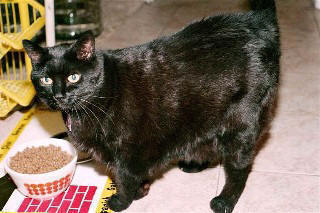 We
have experienced the problems of an overweight pet firsthand with our cat Connie
(shown to the right when she was obese). She became obese in middle age from
eating dry kibble food that we left down all the time (free-feeding of food and
feeding of dry kibble to cats are two "no-no's" if you want a healthy, slim
cat). As a result of her obesity, she developed severe arthritis in her old age.
X-rays show that her left knee has bone chips in it, most likely caused by an
undiagnosed tear of her knee ligament when she was younger, due to her obesity.
We have spent much time and money pursuing both conventional and alternative
treatments, with minimal success, trying to alleviate the pain of her arthritis
and increase her mobility. One of the drugs we tried for her arthritis caused
acute kidney failure, resulting in 4 days in the hospital. If we had not
allowed her to get fat in the first place, she would not be suffering like this
now in her senior years and our vet bills would be much lower. While her
life has not been significantly shortened by
obesity (she is over 20 years old),
she has suffered for years from the pain of arthritis due to it. We have been
able to improve her health and longevity by improving her diet and slimming her
down in her old age, however it is too late to undo the joint damage caused
by her previous obesity.
We
have experienced the problems of an overweight pet firsthand with our cat Connie
(shown to the right when she was obese). She became obese in middle age from
eating dry kibble food that we left down all the time (free-feeding of food and
feeding of dry kibble to cats are two "no-no's" if you want a healthy, slim
cat). As a result of her obesity, she developed severe arthritis in her old age.
X-rays show that her left knee has bone chips in it, most likely caused by an
undiagnosed tear of her knee ligament when she was younger, due to her obesity.
We have spent much time and money pursuing both conventional and alternative
treatments, with minimal success, trying to alleviate the pain of her arthritis
and increase her mobility. One of the drugs we tried for her arthritis caused
acute kidney failure, resulting in 4 days in the hospital. If we had not
allowed her to get fat in the first place, she would not be suffering like this
now in her senior years and our vet bills would be much lower. While her
life has not been significantly shortened by
obesity (she is over 20 years old),
she has suffered for years from the pain of arthritis due to it. We have been
able to improve her health and longevity by improving her diet and slimming her
down in her old age, however it is too late to undo the joint damage caused
by her previous obesity.
Many owners are in denial about their pet's obesity. People often don't think
their pet is overweight but the statistics say otherwise. How do you know if
your pet is overweight? It's not that hard to determine—your pet should have
a waist when viewed from above and a "tuck up" at the abdomen when viewed from
the side. A Purina researcher developed the following Body Condition System
that veterinarians follow for assessing the condition of a dog from visual
inspection (www.purina.com/dogs/health/BodyCondition.aspx).
Numbers 4 and 5 below are ideal. 1-3 is too thin and 5 or above is too heavy:
For a simple way to rate your dog, see:
www.longliveyourdog.com/twoplus/RateYourDog.aspx.
So, what can you do if your pet is overweight? We don't suggest putting
your pet on one of the diet varieties of dry kibble, since they contain too much
fiber and not enough nutrients for good health. And they may be too low in
protein and fat. As carnivores, dogs and cats need protein and fat in their
diet, with cats needing a higher level of fat than dogs. Cats have no
need for carbohydrates and dogs have minimal need (it may vary depending on
the individual dog and their breed). Carbohydrates tend to make carnivores
fat. Since dry kibble requires carbohydrates to hold it together, many pets
get fat on a kibble diet. Pet owners often complain that their pet is fat even
though they feed just a small amount of kibble. Most holistic vets would suggest
getting rid of the kibble and instead feeding a home-cooked, canned or raw diet
that contains minimal carbohydrates. Think "Catkins" diet for your cat or dog,
not "weight loss" kibble.
It's important to use common sense in determining how much to feed your pet,
rather than just following the recommendations of the pet food manufacturer.
The pet food bags often have recommendations for amounts that are too high
(and this is true of not just kibble but also canned and raw foods). Even if the
pet food manufacturer has a feeding calculator on their website that allows for
different activity levels, you can still come up with much too high an amount of
food being recommended. Look at your pet and see if they are overweight or not.
If they are overweight, feed them less until you get them down to a normal
weight. If they're not losing weight, feed them less. Older pets require much
less food than younger ones and the activity level makes a big difference in
how much food your pet requires. A professional agility dog will need much more
food than a couch potato dog. You don't need a food scale, measuring cup or
calorie counter to determine how much to feed. It's real simple--if your pet
is overweight, cut back, and if they are too thin, feed more. Note: If your
pet has any health issues, check with your veterinarian before changing the type
or amount of food you feed.
Switching your pet's diet from dry kibble to a healthier diet can be tricky if
they are hooked on kibble. If you have been leaving kibble down all the time,
the first step is to pick it up and only feed it at mealtimes. Leaving kibble
down and letting pets "free feed" is a quick way to an obese pet and is
not the natural way for carnivores to feed. Herbivores (cows, horses, etc.)
graze continuously while carnivores (wolves, cats) catch their prey, eat it,
then fast until their next catch. Once your pets are used to eating only at
mealtimes, then you can try other foods besides kibble. Cats can be particularly
difficult to switch from kibble, refusing new foods even if they have skipped a
meal or two. According to pet nutrition expert
Jean Hofve, DVM,
cats may refuse new foods to the point of starving themselves. For tips on
how to switch cats, see Jean's article here:
www.littlebigcat.com/index.php?action=library&act=show&item=switchingfoods.
Be especially careful about switching an obese cat, as they are prone to
hepatic lipidosis (fatty liver) disease which can quickly kill them if they
don't eat for a day or two, or if their weight loss is too drastic. Slow and
steady is best with obese cats. Dogs are usually easier to switch to a new
diet and fasting a dog for a day or two is generally safe unless they are prone
to low blood sugar (as with some toy breeds). Some dog owners fast their dogs
for a day each week to give their digestive system a rest.
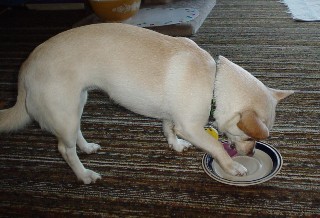 We
got our cat Connie's weight down by taking her off kibble and giving her 2 meals
per day of canned and raw food. We also added
BioPreparation algae to her diet,
which boosted her metabolism and provided essential enzymes for digestion and
health. Her thyroid was low and came up to normal after a few months on the
algae and we reduced her weight from 16 lbs.
down to 11 lbs. Many dogs also have low thyroid function, contributing to their obesity.
BioPreparation
holistically
balances the endocrine system, helping normalize the thyroid and other glands.
Our Chihuahua-mix dog, Mikki, was skinny when we got her from the shelter but
she easily puts on weight now if we feed her too much, especially as she gets
older. Her ideal weight is between 9-10 pounds. If we see her waistline filling
out or her weight goes above 10 pounds, we cut back on her food (including
treats and table scraps) until we get her back to ideal. Notice the "tuck up"
in Mikki's abdominal area in the picture to the right. That is what you see
in a dog of normal weight. We typically give Mikki only a tablespoon or so of
raw food morning and night, which allows room for training treats and some table
scraps in her diet. Just out of curiosity, I looked at the bag of raw patties we
feed, to see how much they recommend feeding. The bag says to feed about 1˝-2
patties per day for a dog of her weight. I had to laugh at that because if we
gave her that much, she would soon weigh 20 pounds or more! It takes us a least
a couple of days to go through one patty. If we didn't give her treats and
scraps, we could feed more. But if you are using positive training methods with
your dog (which we suggest), then you have to allow for part of the diet
being training treats. And since we eat a healthy diet of organic meats,
vegetables and raw dairy, we give her some table scraps as well, to increase the
variety in her diet. If you eat junk food, then don't give your dog table
scraps!
We
got our cat Connie's weight down by taking her off kibble and giving her 2 meals
per day of canned and raw food. We also added
BioPreparation algae to her diet,
which boosted her metabolism and provided essential enzymes for digestion and
health. Her thyroid was low and came up to normal after a few months on the
algae and we reduced her weight from 16 lbs.
down to 11 lbs. Many dogs also have low thyroid function, contributing to their obesity.
BioPreparation
holistically
balances the endocrine system, helping normalize the thyroid and other glands.
Our Chihuahua-mix dog, Mikki, was skinny when we got her from the shelter but
she easily puts on weight now if we feed her too much, especially as she gets
older. Her ideal weight is between 9-10 pounds. If we see her waistline filling
out or her weight goes above 10 pounds, we cut back on her food (including
treats and table scraps) until we get her back to ideal. Notice the "tuck up"
in Mikki's abdominal area in the picture to the right. That is what you see
in a dog of normal weight. We typically give Mikki only a tablespoon or so of
raw food morning and night, which allows room for training treats and some table
scraps in her diet. Just out of curiosity, I looked at the bag of raw patties we
feed, to see how much they recommend feeding. The bag says to feed about 1˝-2
patties per day for a dog of her weight. I had to laugh at that because if we
gave her that much, she would soon weigh 20 pounds or more! It takes us a least
a couple of days to go through one patty. If we didn't give her treats and
scraps, we could feed more. But if you are using positive training methods with
your dog (which we suggest), then you have to allow for part of the diet
being training treats. And since we eat a healthy diet of organic meats,
vegetables and raw dairy, we give her some table scraps as well, to increase the
variety in her diet. If you eat junk food, then don't give your dog table
scraps!
Besides controlling how much your pet eats and cutting back if they are
overweight, it's important for your pets to get adequate exercise. A
study in Australia showed that more than half of dog owners did not walk their
dogs (www.mja.com.au/public/issues/175_12_171201/bauman/bauman.html).
Like Americans, they are probably just sticking them out in the yard because
they are "too busy" to walk them. A dog in the yard isn't going to get
adequate exercise unless they have other dogs to play with and you have a
very large yard. Your dog needs to be walked or run or taken to the dog park,
agility class or other activities where they can run around. Cats need exercise,
too, and indoor cats should get daily play sessions, so they don't just
lie around all day sleeping, especially as they get older.
To learn more about how to reach and maintain your pet's ideal weight by feeding the optimum diet for dogs and cats, read our Holistic Choices e-Book:
Optimum nutrition for dogs and cats available here:
www.optimumchoices.com/e-books.htm.
Your investment will pay big dividends as you
extend your pet's life expectancy and they have lower vet bills as they age.
We also recommend the new audio series
by pet food experts Dr. Jean Hofve and Jan Rasmusen,
How Not to Kill Your
Dog or Cat, available from Optimum Choices here:
www.optimumchoices.com/How_NOT_to_Kill_Your_Pet.htm.
To learn more about holistic dog care, read Jan Rasmusen's book reviewed below
as our Book of the Month.
Note: This article is educational in nature and is not intended to be a substitute for veterinary care. If your animal has any health issues including obesity, please have your veterinarian evaluate your animal before making dietary changes. To find a holistic vet, go to: www.holisticvetlist.com.
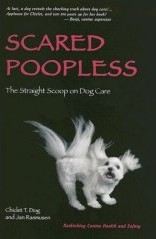 Scared Poopless: The Straight Scoop on Dog Care
Scared Poopless: The Straight Scoop on Dog CareThis book, told from the point of view of Jan's Maltese dog Chiclet, is delightful to read as well as packed full of great information. After Jan's Maltese dog Jiggy got sick, Jan started researching dog care and learned many things contrary to the conventional, accepted point of view. In her research for the book, she interviewed dozens of experts, including 18 veterinarians, distilling their wisdom while making accessible to the layperson. This book is very comprehensive, not only covering the usual holistic topics of food, vaccinations and pest control but many other topics such as dental care (including anesthesia-free teeth cleaning), spaying/neutering, anesthesia, how to deal with surgery, where to acquire your dog from, missing pets, how to keep your dog safe in the car, canine air travel, rehoming your dog, providing for your dog if you die first and euthanasia. Some of the holistic veterinarians providing expertise for the book include Richard Pitcairn, Jean Dodds, Martin Goldstein and Jean Hofve. While we don't agree with every point in the book, overall it is an excellent resource on how to care for your dog in a holistic fashion (including the use of conventional medicine) and it is much more wide ranging and comprehensive than most books on holistic pet care. The humor in the book makes it a fun read and the pictures of dogs, especially Jan's dogs, are just delightful, particularly the ones introducing each chapter. The chapter on vaccinations has a picture of Chiclet blindfolded and tied to a dartboard with giant vaccination syringes aimed at her (hilarious, yet also very appropriate, when we think of what vaccinations can do to our dogs' health). This book is a great resource for anyone that has a dog, whether a new or experienced dog owner. And don't miss Jan's new audio series on pet nutrition with Dr. Jean Hofve, available on Optimum Choices' website here: www.optimumchoices.com/shop.htm#DVDs.
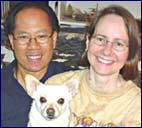 |
Click here
to give your pet |
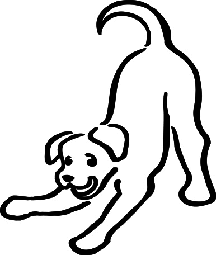 |
General Information: Russell@OptimumChoices.com
Webmaster:
Webmaster@OptimumChoices.com
Newsletter Editor, Margaret Auld-Louie:
Editor@OptimumChoices.com
303-271-1649
866-305-2306 (toll-free)
Normal office hours are 11:00 AM – 7:00 PM Mountain Time (U.S.). If you would
like a return call outside those hours, please specify what days and times are
best.
416 Plateau Pkwy
Golden, CO 80403-1533
U.S.A.
|
|